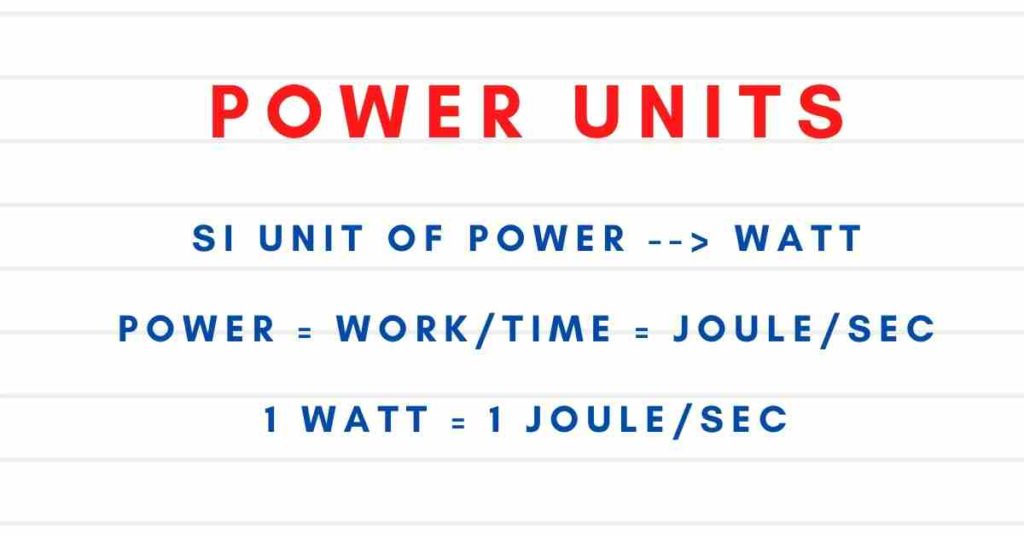Power is defined as energy divided by time. The unit of power in the International System of Units (SI) is the watt (W), which is equal to one joule per second. Other popular and conventional power units include horsepower (hp), which compares to horsepower; one mechanical horsepower equals approximately 745.7 watts.

Table of Contents
What is power?
Power is the rate at which work is completed. It’s the work-to-time ratio. It is calculated mathematically using the following equation.
Power = work/time
P = W (Joule)/time (sec)
The Watt is the standard metric unit of power. As suggested by the power equation, a unit of power (power unit) is equivalent to a unit of work divided by a unit of time. As a result, a Watt equals a Joule/second. For historical reasons, horsepower is sometimes used to indicate the power provided by a machine. One horsepower is roughly equal to 750 watts.
Since work is a product of force and displacement.
The expression for power can be rewritten as
Power = (Force x displacement )/time
P = (F x d)/t
P = F x v (velocity = displacement/time)
Power Units
Power may be represented in a variety of ways, the most common of which is as a unit of energy divided by a unit of time. The watt (W) is the most often used unit, and it is defined as one joule (J) of energy per second.
| Units | Abbreviation | Equivalent Watt Unit |
| Horsepower | HP | 746 watts |
| Kilowatts | kW | 1×103 watts |
| Megawatts | MW | 1×106 watts |
| Gigawatts | GW | 1×109 watts |
Horsepower
When steam engines began to replace horses in mines in the early 1800s, mine owners began to wonder how many horses one engine would replace. James Watt, the inventor of steam engines, devised a mathematical formula for converting horsepower to engine power. As a result, the term “horsepower” was coined.
Horsepower is the amount of power produced by an engine. It is estimated as the force required to move 550 pounds one foot in one second or 33,000 pounds one foot in one minute. The power is measured by the time it takes to complete the task.
Joule Definition
In the International System of Units (SI), a joule is a unit of work or energy equal to the work done by a force of one newton acting through one meter. The joule is equivalent to one watt-second in physics terms, which is the amount of energy released in one second by a current of one ampere through a resistance of one ohm.
Daily Life Examples of Power
- A 60-W incandescent bulb converts only 5 W of electrical power to light, with 55 W dissipating into thermal energy.
- When you race up the stairs, you work much more quickly. You have more power when racing up the stairs than when walking up them.
- The amount of work is the same whether you run up a flight of stairs in 5 seconds or take a slow walk up the same staircase in 40 seconds.
- The strength needed to run three miles
- Sunlight reaching Earth’s surface carries a maximum power of about 1.3 kilowatts per square meter (kW/m2).
Summary
- Power is the rate of work done. Mathematically, it is energy per unit of time.
- Power units are watts. One watt is one joule per second.
- A joule is defined as work done by a force of one newton acting through one meter.
- A horse’s power is equal to 746 watts.
Sloved Numerical Problems of Power
- A car engine produces 150 horsepower (hp) and operates for 2 hours. What is the energy output of the engine in joules, and what is the power output in watts?
We first need to convert the horsepower into watts. One horsepower is equivalent to 746 watts.
Power output = 150 hp * 746 W/hp = 111,900 W Energy output = Power output * time taken = 111,900 W * 2 hours * 3600 seconds/hour = 805,920,000 J
Therefore, the energy output of the engine is 805,920,000 joules, and the power output is 111,900 watts.
- A person lifts a 50 kg weight to a height of 2 meters in 4 seconds. What is the power output of the person?
To calculate the power output, we first need to find the work done by the person.
Work done = force x distance moved = mgd = (50 kg) x (9.8 m/s^2) x (2 m) = 980 J
Power output = Work done / time taken = 980 J / 4 s = 245 W
Therefore, the power output of the person is 245 watts.
Related Links
Can force be Negative?| Easy Explanation
Mass Vs Weight| 5 Easy Examples
Flexural Strength- An Overview
Thermal Mass| A Brief Introduction
Can work be negative? (Easy Explanation)
Frequently Asked Questions
1. What are power units?
Power is defined in physics as the quantity of energy delivered or transformed per unit of time. The watt is the unit of power in the International System of Units, equivalent to one joule per second.
2. What is the ultimate source of energy?
The Sun is both the ultimate source of energy and our primary source of energy. Crop production (photosynthesis) is driven by sunlight, and all of our fossil fuels are derived from plants that existed millions of years ago.
3. What is light energy?
Light energy is a type of energy that is visible to the human eye and moves as transverse waves with a wavelength of 400–700 nanometers. Hot things, such as lasers, lights, and the sun, emit an electric pulse known as light. Some examples of light energy are light from stars, fire, the sun, glowing coils, electric bulbs, flashlights, lasers, and light from kerosene lamps.
4. What is mechanical energy?
Mechanical energy is the energy that an item possesses as a result of its motion or location. Mechanical energy can be kinetic energy (motion energy) or potential energy (stored energy of position).
5. What is relativistic kinetic energy?
According to the relativistic kinetic energy equation, when an object’s velocity approaches the speed of light, its energy approaches infinity. As a result, exceeding this speed restriction is impossible.
Both the rest mass energy and the kinetic energy of motion are included in the relativistic energy formulation. Check out the full article on relativistic kinetic energy definition, explanation, and equation.
6. Can kinetic energy be negative?
Kinetic energy can never be a negative quantity. It is never less than or equal to zero.
A moving object’s K.E equals half the product of its mass and the square of its velocity.
Because an object’s mass can never be zero, and the square of velocity results in a positive response.
Kinetic energy, as a result, can never be negative.
7. What is the malleability of a material?
Malleability refers to a substance’s ability to distort under pressure. The material can be pounded or rolled into thin sheets if it is pliable. Metal malleability refers to the ability of a metal to deform under compression and take on a new shape.
8. flexural strength?
A material’s flexural strength is the highest bending force that can be applied to it before it yields. A transverse bending test employing a three-point flexural test methodology is the most popular method of assessing a material’s flexural strength.
8. gauge pressure formula
The pressure in a system that is greater than atmospheric pressure is referred to as gauge pressure, also known as overpressure. Gauge pressure readings include atmospheric pressure since they are zero-referenced against ambient air (or atmospheric) pressure.
9. Instantaneous velocity?
The rate of change of position over a very short period of time is defined as instantaneous velocity.
10. Gravitational potential energy
The energy that an object has as a result of its location in a gravitational field is referred to as gravitational potential energy (w). If the object is pushed straight up at a constant speed, the force (F) necessary to hoist it to the height (h) is equal to the object’s weight (mg).
11. What are quarks in physics?
In physics, quarks are the fundamental building units of matter. They are most typically found inside protons and neutrons, the particles that form the nucleus of every atom in the universe. Based on present experimental findings, quarks appear to be really basic particles that cannot be further subdivided.
12. What is the ability to do work called?
Energy is the ability to do work, and work is the movement of anything against a force, such as gravity.
13. What is linear motion?
Linear motion is a one-dimensional motion along a straight line that can be represented mathematically with only one spatial dimension.
More Interesting Topics
Can Displacement be Negative?
Flexural Strength- An Overview
Magnetic Permeability
Momentum Equation| Definition and Examples
Is Titanium Magnetic?
Weight of water
- BCl3 Lewis Structure in four simple steps - November 1, 2023
- PH3 Lewis Structure in four simple steps - October 8, 2023
- PF3 Lewis structure in four simple steps - September 24, 2023



